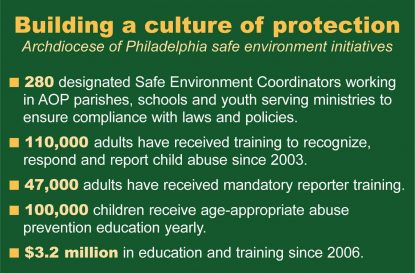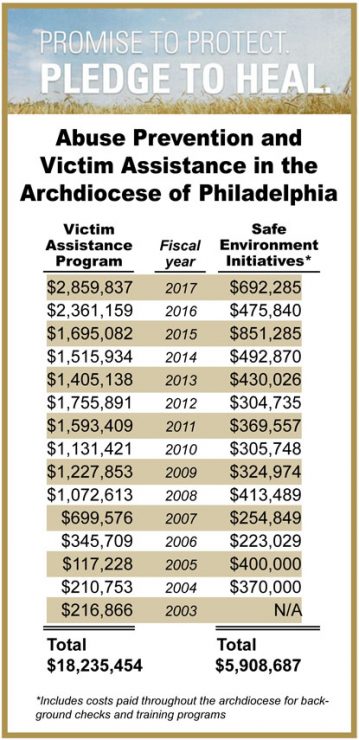 April is Child Abuse Prevention Awareness Month, and on April 23 the Archdiocese of Philadelphia will conduct a conference on the topic for safe environment coordinators and facilitators at the Doubletree by Hilton in King of Prussia.
April is Child Abuse Prevention Awareness Month, and on April 23 the Archdiocese of Philadelphia will conduct a conference on the topic for safe environment coordinators and facilitators at the Doubletree by Hilton in King of Prussia.
A letter announcing this conference written by Archbishop Charles Chaput was sent to all archdiocesan priests and deacons earlier this month.
In his letter the archbishop took note of the recently publicized case of Dr. Larry Nassar of Michigan State University. Nassar, according to news reports, abused “at least 250 victims.” Although he was found guilty and faces 40 to 125 years in prison, MSU alone could face $500 million in cost and penalties.
“The Nassar story teaches two lessons,” Archbishop Chaput wrote. “First, it reconfirms the fact that sexual abuse, including the sexual abuse of minors, is a serious national problem cutting across all institutions and professions, public and private.
[hotblock]
“Second, and even more importantly, it reminds all of us as clergy our responsibility to report suspected abuse to civil authorities, to educate our staff and volunteers to recognize the signs of sexual abuse and grooming behavior, and to take all steps needed to ensure the safety of the families in our parishes and students in our Catholic schools.
“No protective system can ever be perfect, but we need to continue our ongoing commitment to vigilance on this issue and doing all we can to prevent abuse in the future,” the archbishop wrote.
The conference is organized and facilitated by Leslie Davila and the archdiocesan Office for Child and Youth Protection (OCYP). It is expected to attract more than 200 participants for professional development and training to further ensure the archdiocese is doing everything possible to protect children.
Background material provided by OCYP outlines steps taken by the archdiocese to prevent child abuse, including all people who work with children. Clergy, lay employees and volunteers must undergo criminal background checks, obtain child abuse clearances and complete safe environment as well as mandated reporter training programs.
Young people in grades K-12 receive age-appropriate abuse protection education and all archdiocesan employees and volunteers who have contact with children are required to report suspicions of child abuse to law enforcement authorities.
The material states a “zero-tolerance policy” in the archdiocese for any acts of misconduct or abuse of children on behalf of priests, deacons, lay staff and volunteers. The archdiocese, it said, “takes immediate action when an accusation is made.”
 An OCYP fact sheet shows the archdiocese has paid out more than $18.2 million to assist the needs of victims of child abuse since 2003, with $2.8 million in fiscal year 2017, and more than $5.9 million for safe environment initiatives since 2004, with $692,285 in fiscal year 2017.
An OCYP fact sheet shows the archdiocese has paid out more than $18.2 million to assist the needs of victims of child abuse since 2003, with $2.8 million in fiscal year 2017, and more than $5.9 million for safe environment initiatives since 2004, with $692,285 in fiscal year 2017.
In all, the archdiocese has spent more than $24 million since 2003 to aid victims of abuse and build a safe environment for children and young people in the church.
“We continue to be responsive to the needs of survivors and implementing the best policies and procedures as well,” Davila said. “We are in compliance with what the law requires. We encourage victims to come forward to us and also report to law enforcement.”
Most of the cases the Office for Child and Youth Protection is dealing with, Davila explained, “are predominantly allegations that go back many years with accused perpetrators either deceased or no longer in ministry.”
The essential message, she said, is “child abuse is a vital problem. We all have a role in preventing abuse and also helping survivors.
“We do a lot of outreach, encouraging victim survivors to come forward. We encourage them to contact law enforcement but also come to us if they are seeking assistance.”
The work of protecting children and reporting allegations of possible abuse “is ongoing,” she said. “If a new allegation comes forward we will make the notification.”
Don’t be surprised if you see more people wearing blue clothing or a blue ribbon during the month of April and blue pinwheels planted in odd places.
Blue is the color nationally chosen to represent child abuse awareness, and the pinwheel is a symbol of the innocence of childhood that can be shattered by sexual abuse, Davila explained.
PREVIOUS: Bishop DeSimone, friend of Augustinians, to receive order’s honor
NEXT: 104 priests learn of marriage support, youth concerns in archdiocese



Good report on the issue, but a first reaction says that a description of the Archdiocesan policies on vetting and forming priests to identify and prevent potential trouble might complete the picture, since priests have been central to the issue in Philadelphia. If archbishops and pastors had honestly dealt with the problem, the number of victims and the cost of settlement might have been a great deal less than reported here. Interesting to hear the cost of education and awareness.